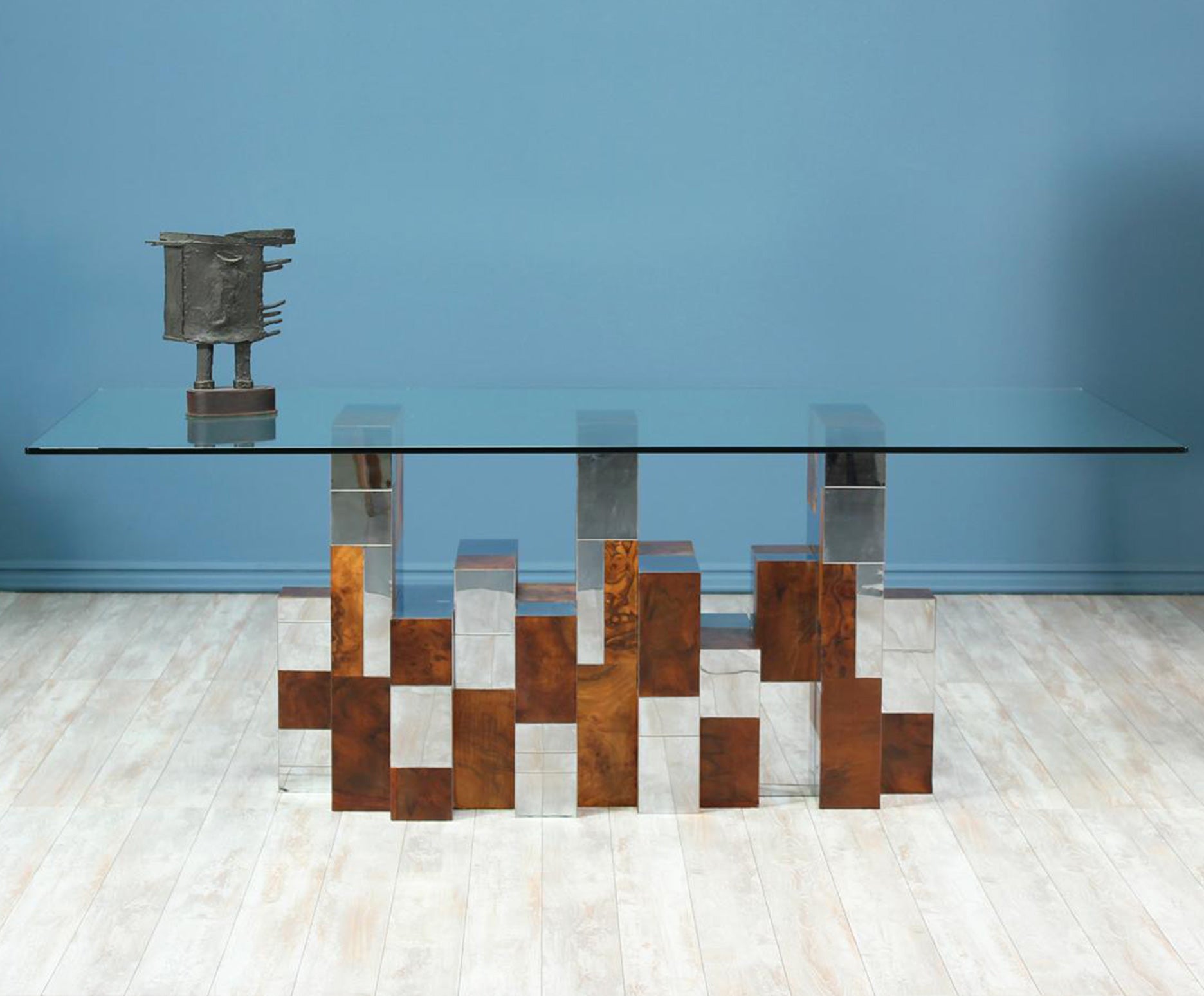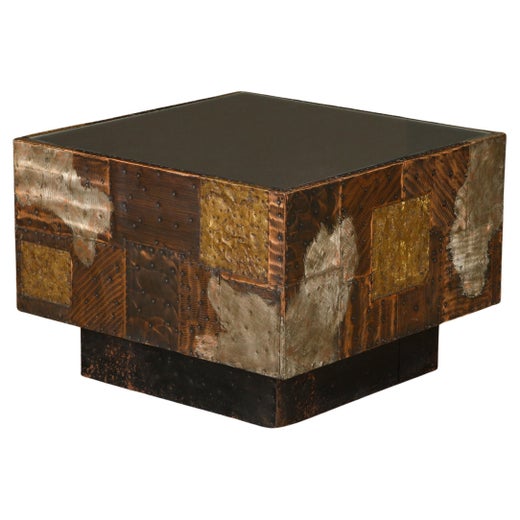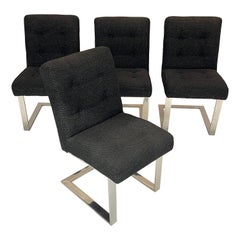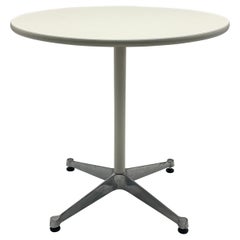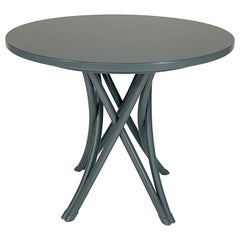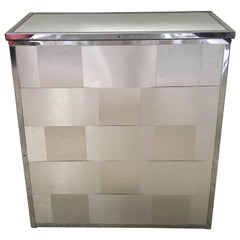Paul Evans PE 400 Series "Cityscape" Dining Table for Directional , USA 1970s
About the Item
- Creator:Directional (Manufacturer),Paul Evans (Designer)
- Design:
- Dimensions:Height: 28.25 in (71.76 cm)Width: 50 in (127 cm)Depth: 19.25 in (48.9 cm)
- Style:Mid-Century Modern (Of the Period)
- Materials and Techniques:
- Place of Origin:
- Period:
- Date of Manufacture:1970s
- Condition:Wear consistent with age and use. Original Vintage Condition, some spots chrome and veneer as seen in images, one small veneer loss at the bottom of the piece, does not distract from the beauty of the piece.
- Seller Location:Miami, FL
- Reference Number:1stDibs: LU1105240282992
Cityscape Dining Table
The Cityscape dining table created by artist, sculptor and furniture designer Paul Evans (1931–87) is one of the most recognizable examples of brutalist design. Evans, whose favored material was metal, is best known for his 1970s contributions to the American Studio Craft movement as well as his breakthroughs in brutalism. In the early 1950s, Evans studied at Philadelphia’s Textile Institute and then at the Rochester Institute of Technology and Michigan’s Cranbrook Academy of Art, which has counted among its students and faculty Charles and Ray Eames, Florence Knoll, Eero Saarinen and many more towering design figures.
Later in the decade, Evans moved to New Hope, Pennsylvania, not far from the Bucks County town in which he was raised, and joined with woodworker Phillip Lloyd Powell in a decade-long partnership. Evans and Powell collaborated on a significant series of pieces, often procuring discarded wood from furniture maker George Nakashima, who had a neighboring studio. In 1964, Evans teamed with North Carolina manufacturer Directional Furniture, for which he designed classic lines, including the 1970s-era Cityscape series, which in addition to the dining table, included a coffee table, floor lamps, a credenza and more.
Although based in Pennsylvania, Evans found the inspiration for his Cityscape dining table in New York City’s crowded skyline — specifically, in the Art Deco office buildings and stately spires. Beneath the piece’s beveled glass tabletop, in a base fashioned from brass, chromed steel and walnut burlwood, Evans’s decorative clusters of boxy forms echo Manhattan’s blocky building tops and wealth of window glass. It’s clear that the Cityscape series has roots in Evans’s affinity for urban landscapes, but the line’s sculptural attributes rendered the work outlandish in modest living spaces — so much so that a Directional print advertisement characterized the designs as “startling.”
Paul Evans
A designer and sculptor, Paul Evans was a wild card of late 20th century modernism. A leading light of the American Studio Furniture movement, Evans’s sideboards, credenzas, coffee tables and other work manifests a singular aesthetic sense, as well as a seemingly contradictory appreciation for both folk art forms and for new materials and technologies.
Evans’s primary material was metal, not wood, which was favored by his fellow studio designers, and Bucks County, Pennsylvania, neighbors George Nakashima and Phillip Lloyd Powell. He trained in metallurgy and studied at the Cranbrook Academy of Art, the famed crucible of modern design and art in suburban Detroit. For a time early in his career, Evans also worked at Sturbridge Village, a historical “living museum” in Massachusetts, where he gave demonstrations as a costumed silversmith.
Evans’s earliest work unites these influences. The pieces that made his reputation are known as “sculpted-front” cabinets: wood cases faced with box-like high-relief patinated steel mounts laid out in a grid pattern. Each mount contains a metal emblem, or glyph, and the effect is that of a brawny quilt.
Evans’s later work falls into three distinct style groups. His sculpted-bronze pieces, begun in the mid-1960s, show Evans at his most expressive. He employed a technique in which resin is hand-shaped, and later sprayed with a metal coating, allowing for artistic nuance in the making of chairs, tables and case pieces. Later in the decade and into the 1970s, Evans produced his Argente series for celebrated manufacturer Directional (a brand known to vintage mid-century modern furniture collectors everywhere): consoles and other furniture forms that feature aluminum and pigment-infused metal surfaces welded into abstract organic forms and patterns.
Last, Evans's Cityscape design series — a milestone in the history of brutalist design — meshed perfectly with the sleek, “high tech” sensibility of the later ’70s. Evans constructed boxy forms and faced them with irregular mosaic patterns that mixed rectangular plaques of chromed steel, bronze or burlwood veneer. These, like all of Paul Evans’s designs, are both useful and eye-catching. But their appeal has another, more visceral quality: these pieces have clearly been touched by an artist’s hand.
Find a collection of authentic Paul Evans furniture today on 1stDibs.
You May Also Like
Vintage 1970s American Mid-Century Modern Dining Room Tables
Brass, Chrome
Vintage 1970s American Mid-Century Modern Dining Room Tables
Mirror, Wood
Vintage 1970s American Mid-Century Modern Dining Room Tables
Metal, Bronze, Cut Steel
Vintage 1970s American Mid-Century Modern Dining Room Tables
Chrome
Vintage 1970s American Mid-Century Modern Dining Room Tables
Chrome
Vintage 1970s American Mid-Century Modern Dining Room Tables
Chrome
Vintage 1970s American Modern Dining Room Tables
Steel, Chrome
Vintage 1970s American Mid-Century Modern Dining Room Tables
Bronze
Mid-20th Century American Mid-Century Modern Dining Room Tables
Brass
Vintage 1960s Mid-Century Modern Dining Room Tables
Chrome
More From This Seller
View AllMid-20th Century American Mid-Century Modern Dining Room Chairs
Steel, Chrome
21st Century and Contemporary American Modern Dining Room Tables
Aluminum
2010s Austrian Modern Dining Room Tables
Wood, Beech, Bentwood
Mid-20th Century American Mid-Century Modern Trunks and Luggage
Aluminum
Mid-20th Century American Mid-Century Modern Serving Pieces
Aluminum
Mid-20th Century American Mid-Century Modern Tableware
Acrylic, Lucite
